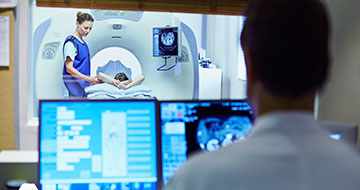Cranial Nerves
A brain tumor is formed when a cluster of cells in the brain start to grow irregularly. Like other tumors, brain tumors ...
Meningiomas, also called meningioma tumors, are the most common type of primary brain tumors.
TBI, or Traumatic Brain Injury has been a major health concern and occurs when there is an injury to the head that...
{{SearchTerm}}
Seek immediate medical attention if you are experiencing this symptom.
We didn’t find an exact match for your request. Here are others to consider:
The closest doctor is {{ ClosestMiles }} miles away.
There are no results within {{ SelectedMiles }} miles of your location. Please find closest below:
Physician specialty matches Doctor Results for {{ SearchTerm }}{{ CommonSearchTermValue }}{{ BySpecialties }} near {{ ByZipCode }}
{{Title}}
{{physician.FirstName}} {{physician.LastName}}, {{physician.Title}}
{{PrintSpecialties(physician.Specialties, "Name")}}

miles
{{addressInfo(physician.Addresses, 0, "Group")}}
- {{addressInfo(physician.Addresses, 0, "Address1")}}
- {{addressInfo(physician.Addresses, 0, "Address2")}}
- {{addressInfo(physician.Addresses, 0, "City")}}{{VueFilterInfo(physician.Addresses,0,'State') ? ',' : '' }} {{addressInfo(physician.Addresses, 0, "State")}} {{addressInfo(physician.Addresses, 0, "Zip")}}
Your selected filters found no results. Please adjust your filter selection.
Please Wait Details Loading.
{{PhysicianDetails.FirstName}} {{PhysicianDetails.LastName}}, {{PhysicianDetails.Title}}
{{ PrintSpecialties(PhysicianDetails.Specialties, "Name")}}
Primary Location
{{ addressInfo(PhysicianDetails.Addresses, 0, "Group")}}
- {{addressInfo(PhysicianDetails.Addresses, 0, "Address1")}}
- {{addressInfo(PhysicianDetails.Addresses, 0, "Address2")}}
- {{addressInfo(PhysicianDetails.Addresses, 0, "City")}}{{VueFilterInfo(PhysicianDetails.Addresses,0,'State') ? ',' : '' }} {{addressInfo(PhysicianDetails.Addresses, 0, "State")}} {{addressInfo(PhysicianDetails.Addresses, 0, "Zip")}}
Languages Spoken
{{item.Name}}
Gender
{{PhysicianDetails.Gender === "M" ? "Male" : "Female"}}
About {{PhysicianDetails.FirstName}} {{PhysicianDetails.LastName}}, {{PhysicianDetails.Title}}
{{ SliceAboutMe(PhysicianDetails.AboutMe) }}
Read more about {{PhysicianDetails.FirstName}} {{PhysicianDetails.LastName}}, {{PhysicianDetails.Title}} Read less about {{PhysicianDetails.FirstName}} {{PhysicianDetails.LastName}}, {{PhysicianDetails.Title}}
- {{item.Name}}
-
{{item.Name}}
-
{{item.Name}}
The following insurance plans may be accepted by this provider. Please contact the provider's office directly to confirm insurance plans accepted.
Please contact this provider's office directly to determine insurance plans accepted.
- {{item.Payor}}
- {{item.Name}}
- {{item.Type == 'F' ? 'Fellowship' : ''}}{{item.Type == 'M' ? 'Medical School' : ''}}{{item.Type == 'I' ? 'Internship' : ''}}{{item.Type == 'R' ? 'Residency' : ''}}: {{item.Description}}
Patient Comments
Primary Location
{{addressInfo(PhysicianDetails.Addresses, 0, "Group")}}
- {{addressInfo(PhysicianDetails.Addresses, 0, "Address1")}}
- {{addressInfo(PhysicianDetails.Addresses, 0, "Address2")}}
- {{addressInfo(PhysicianDetails.Addresses, 0, "City")}}{{VueFilterInfo(PhysicianDetails.Addresses,0,'State') ? ',' : '' }} {{addressInfo(PhysicianDetails.Addresses, 0, "State")}} {{addressInfo(PhysicianDetails.Addresses, 0, "Zip")}}
Languages Spoken
{{item.Name}}
Gender
{{PhysicianDetails.Gender === "M" ? "Male" : "Female"}}
Where to Find {{PhysicianDetails.FirstName}} {{PhysicianDetails.LastName}}, {{PhysicianDetails.Title}}
#ResourceNotFound: PhysicianFinderResources, Miles2#
{{plocation.Group}}
- {{plocation.Address1}}
- {{plocation.Address2}}
- {{plocation.City}}{{plocation.State ? ',' : '' }} {{plocation.State}} {{plocation.Zip}}
Understanding Your Pain Management Journey

There’s little else that can get your spirit down quite like dealing with chronic pain. Whether your pain comes from an old sports injury, recent injury, surgery or simply wear and tear, your goal is the same: relief from the discomfort of chronic pain. Your physician’s approach to pain relief depends very much on your particular cause, your age and health. Your doctor will discuss strategic options with you to begin your pain management journey to recovery.
Five Common Pain Management Approaches
- Medication. Considering the opioid crisis in the U.S., doctors are less than enthusiastic to prescribe opioids to their patients, opting rather to prescribe non-opioids like high-dose ibuprofen. In fact, according to the CDC there has been a steady 22% decline in opioid prescriptions since 2013.
- Interventional Procedures. This technique includes nerve blocks, pain relief injections—even electric stimulation. It’s a maintenance solution, but not meant to be long term.
- Rehabilitative and Occupational Therapy. This is healthy (and effective) middle ground that starts you participating in a critical role to your recovery. A physical therapist will work with you to help get you where you need to be, and you can even practice techniques and exercises at home. Rehabilitative therapy generally differs from occupational therapy by addressing an event that led to your pain or injury, such as an accident. Occupational therapy helps you find interventions designed to allow you to lead a more independent daily life, such as using a walker to increase mobility after surgery. Your success depends a lot on you—so hard work does pay off.
- Complementary Alternative Medicine. Many chronic pain sufferers find relief in calming alternative medicine like acupuncture, yoga, as well as meditation. These are termed “complementary” because they are not intended to take the place of traditional techniques, but aid greatly.
- Self-management. This is another good one for people who want to know they can have control over the outcome. Diet and low impact exercise can contribute to pain management. For example, swimming is a wonderful exercise for joint pain sufferers or if you’ve had any type of joint replacement surgery, such as hip replacement.
Your Results Depend On a Positive Attitude and Commitment to Rehabilitation
Don’t get discouraged. Pain management often involves a period of trial and error because everyone’s pain tolerance, injury, health and lifestyle are different — and you will react differently too. Work with your doctor to find the right mix for you.








